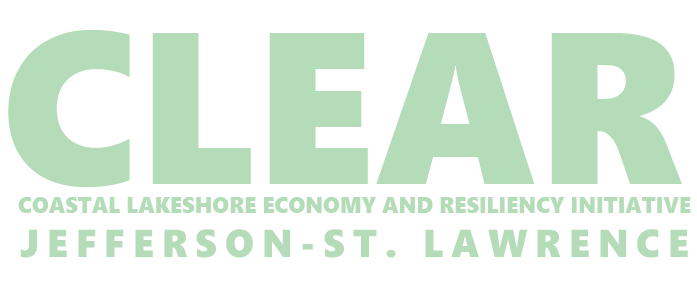
Photo: Town of Lyme, Point Peninsula Isthmus
What is CLEAR?
Communities along the Lake Ontario and St. Lawrence River are preparing for change and strengthening their resiliency through the Coastal Lakeshore Economy and Resiliency (CLEAR) Initiative. In recent years, shoreline communities along Lake Ontario, the St. Lawrence River, and across the Great Lakes, have experienced significant variability, with extreme flood and low-water level events occurring over shorter periods of time. In 2017 and 2019, lake levels rose higher than ever recorded; shortly removed from a period of extremely low water levels in the early 2010s. During these recent flooding events, unprecedented lake levels, heavy rainfall events, and increased development along the shoreline combined to cause millions of dollars in damages to businesses, homes, and public recreational areas.
CLEAR was initiated in late 2020 by the New York State Department of State (NYS DOS) to support local communities with adaptation to extreme water level variability (i.e., high and low water events) along Lake Ontario, the lower Niagara River and the St. Lawrence River. This program aims to address community vulnerability and exposure to changes in lake levels through forward looking approaches that strengthen, complement, and/or facilitate economic development for the region. The intent is to help communities adopt more resilient approaches to shoreline management, land use, and development to reduce the recurrence of damages associated with changing water levels.
CLEAR Plans are intended to reflect the diverse perspectives, needs, interests, and watersheds within each region surrounding Lake Ontario and the St. Lawrence River. The Planning Team for each region will develop these plans under the guidance of NYS DOS and a regional Steering Committee that reflects the socio-economic and geographic diversity of the region, including vulnerable and under-served populations. This planning effort will utilize a robust community engagement process to learn from, educate, and empower the public and local representatives through a series of community workshops and stakeholder outreach.
Throughout this process, the Steering Committee, NYS DOS, and the Planning Team will refine strategies and recommendations intended to assist local communities with the establishment of a more resilient shoreline by:
Engaging coastal communities to plan for and inform a vision that is reflective of the community’s assets, values, and goals
Seeking stakeholder input on ideas, concerns, and priorities for community resiliency
Educating stakeholders and respond to community questions about coastal and community resiliency planning
Communicating the implications of proposed implementation measures to the public
Enhancing public participation through various outreach methods that involve groups that do not typically attend public meetings or participate online

Goals of CLEAR
Provide guidance for vibrant communities to thrive in changing and variable lake levels and conditions.
Create coastal development pattern goals that provide continued opportunities for existing and new recreation and employment.
Connect the coastal environment through resilient innovative strategies and adaptive uses.
Bring together local governments, organizations, and leaders who are empowered to protect their communities and create new, more resilient paths for community growth.
Develop and implement resilience strategies for shoreline property owners and managers.
Key Definitions
Resilience: the capacity for a community and its ecosystem to withstand extreme events and other forces or risks; quickly recover the interconnected social, economic, and ecological systems’ structure and function in the aftermath of a disaster; and develop ongoing adaptability to rapidly changing environmental conditions and forces. Resilience counteracts risk.
Risk: the chance that an asset will be damaged or destroyed. This chance is the consequence of the interaction between a hazard and the characteristics that make people and places vulnerable and exposed.
Hazard: naturally occurring events like storm surges, overwash, flooding, and erosion due to wind, waves, rain, and other natural forces. Drought is also a hazard that can occur from too little precipitation and warmer than normal temperatures. Climate change can exacerbate these normally occurring hazards.
Exposure: the situation of people, infrastructure, housing, production capacities and other tangible human assets located in hazard-prone areas.
Vulnerability: the complex characteristics determined by physical, social, economic and environmental factors or processes which increase the susceptibility of an individual, a community, assets or systems to the impacts of hazards.


